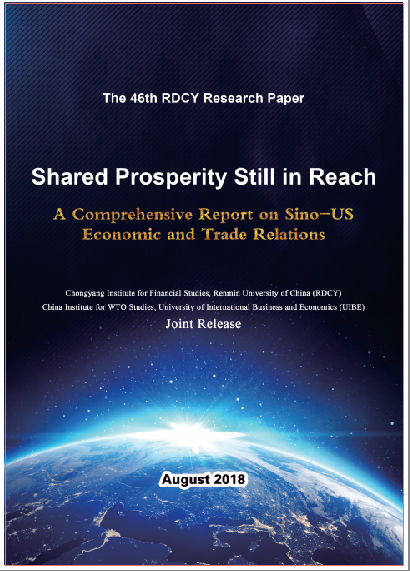Reports
Your Present Location: PUBLICATIONS> ReportsRDCY Research Paper No.46: Shared Prosperity Still in Reach——A Comprehensive Report on Sino-US Economic and Trade Relations

Abstract
Since China's accession to the WTO in 2001, Sino-US trade has maintained a rapid and healthy development momentum. The total volume of import and export trade has been on the rise and the commodity structure has been constantly optimized. Today, China and the United States have become each other's largest trading partners.
At the same time, the two countries have seen ongoing frictions in the field of trade. In March this year, US President Donald Trump announced the imposition of punitive tariffs on Chinese goods worth up to 50 billion US dollars, after which China issued its counter-measures. In July, the United States continued to weigh on China and threw an additional 200 billion US dollars goods into its sanction pool, pouring oil on the flames of trade frictions.
This report focuses on the Sino-US trade frictions and the status quo of their economic and trade cooperation, gets straight to the concerns of all parties, objectively and systematically analyzes the roots, current situation and future trend, and provides reasonable suggestions on the sustainable development of Sino-US economic and trade relations. Below are the highlights of this report:
1. The causes of Sino-US trade friction. This report analyzes the interests of both parties in the field of economic and trade from the perspectives of China and the United States, and finds that cognitive bias is the immediate cause of trade friction between the two sides.
2.The status quo of Sino-US trade friction. This report elaborates the current situation of Sino-US trade friction from the perspectives of event review, tariff list analysis and economic effects.
3.The consequences of Sino-US trade friction. Based on the reasons and the status quo, this report makes a bold prediction on the post-trade disputes era, and comes out with three situations of the trajectory of Sino-US trade relations.
4. How to break the ice of Sino-US "trade war". This report puts forward recommendations for the development of Sino-US relations in the post-trade friction era from five perspectives - expanding imports of goods, infrastructure construction, two-way market opening, bilateral investment agreement negotiations, and Sino-US scientific and technological cooperation.
Key Words: Sino-US relations; RDCY; report























































































 京公网安备 11010802037854号
京公网安备 11010802037854号





